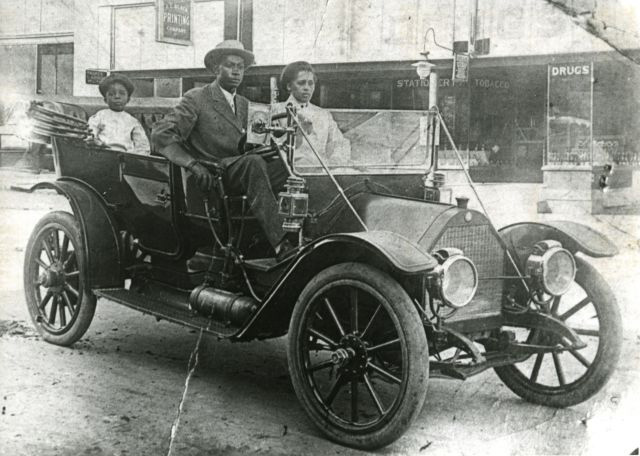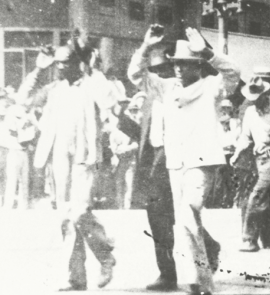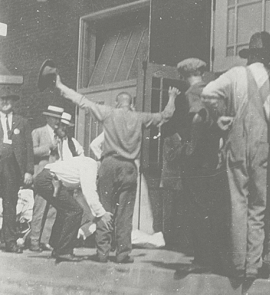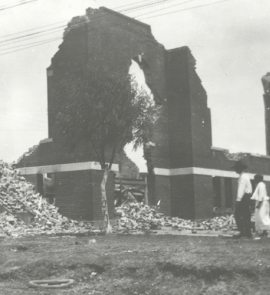Section 1: Black Wall Street

Williams family image provided by the Tulsa Historical Society & Museum. More information on the Williams family in section 2.
The entrepreneurial spirit and success of the Williams family (pictured above) embodies the character of Black Wall Street’s thriving, independent community. Like many other Black individuals and families, John and Loula Williams moved to Tulsa not only to escape racism but to live where their business ventures and enterprises could prosper.
Segregation made Black Wall Street’s insular economy a necessity. This necessity, however, coupled with the vision among Greenwood’s residents to create a self-sufficient district, made Black Wall Street one of the most successful and affluent Black communities in U.S. history.
History of Greenwood
Black Wall Street
Today, Greenwood is widely recognized as “Black Wall Street,” a title bestowed upon the district by the celebrated educator, cultural icon and founder of the Tuskegee Institute Booker T. Washington. As author and educator Eddie Faye Gates writes, Washington visited Greenwood on his way to speak in the all-Black town of Boley, Okla.1 Impressed by the growth and success of Greenwood, he called it “the Negro Wall Street of America,” which evolved into “the Black Wall Street” during the civil rights movement.2
Beginnings of Greenwood
The origins of Greenwood District are tied to Oklahoma’s early Black boosters and visionaries. In 1906, Ottawa W. (O.W.) Gurley purchased 40 acres of land and sold it exclusively to Black settlers. He built a rooming house on a strip of road and named it Greenwood Avenue. Thus, Greenwood was born.
The community grew quickly. Greenwood transformed into a mecca for Black entrepreneurs and attracted the attention of some of the nation’s leading Black figures. By 1921, Greenwood’s population was approximately 10,000 and the district was recognized as one of the preeminent Black communities in the nation. As Hannibal Johnson wrote, “Beautiful, bustling and Black, Greenwood held its own with Chicago’s State Street and Memphis’ Beale Street.”3
Out of Vision and Necessity
Despite residential and commercial segregation ordinances, many Greenwood residents worked for white employers. Largely prohibited from patronizing Tulsa’s white-owned stores, Greenwood’s workers and families turned to Black-owned businesses in the community to supply their needs and wants.
In response, more Black-owned businesses sprouted and flourished in the district, generating a cycle of investment in Greenwood. “Thus, in the early years of the twentieth century, Tulsa became not one city, but two. Confined by law and by white racism, Black Tulsa was a separate city, serving the needs of the Black community. And as Tulsa boomed, Black Tulsa did too.”4
Read an extended version on the history of Greenwood.
1. Gates, E. F. (2003). Riot on Greenwood: The Total Destruction of Black Wall Street (Illustrated ed.). Page 25. Eakin Press.
2. This Land Magazine, & Ross, J. K. (2017). A Conspiracy of Silence. In The Race Reader: A Literary Chronicle of Conflict and Oppression in the Middle of America. Page 24. This Land Press.
3. Johnson, H. B. (2007). Black Wall Street: From Riot to Renaissance in Tulsa’s Historic Greenwood District (Illustrated ed.). Page 26. Eakin Press.
4. Ellsworth, S., & Franklin, J. H. (1992). Death in a Promised Land: The Tulsa Race Riot of 1921 (8th Print ed.). Page 14. LSU Press.
Businesses on Greenwood
Highlights
- By 1921 the Greenwood Business District had 108 Black-owned businesses.
- These businesses covered professional, retail and entertainment services.
- In segregated Tulsa, “buying Black” became more a matter of survival and less a matter of choice.
The hub of any community is the well-developed commercial district, and North Tulsa’s district sat at the southern end of Greenwood Avenue. The Greenwood District ran north for more than a mile from Archer Street and the Frisco railyards past Pine and Greenwood Avenue. This was not only Black Tulsa’s primary thoroughfare; it also possessed considerable symbolic meaning to the African American community. The several-block stretch of Greenwood, along with its adjacent side street, was characterized by one-, two- and three-story red brick buildings that housed dozens of Black-owned businesses, organizations and institutions.1
In 1921, the Greenwood section of Tulsa contained 108 Black-owned businesses, including 41 grocery and meat markets, 30 restaurants, 11 boarding and rooming houses, nine billiard halls and five hotels. Greenwood also had 33 Black professionals, including 15 physicians and surgeons; six real estate, loan and insurance agents; four pharmacists; three lawyers; and two dentists. Twenty-four skilled crafts persons in the community included 10 tailors, five building contractors and painters, and four shoemakers. The community’s 26 service workers included 12 barbers, six shoe shiners and five clothes cleaning shops.2
In segregated Tulsa, “buying Black” became more a matter of survival and less a matter of choice. “African Americans could neither live among whites as equals nor patronize white businesses in Tulsa” though many worked as servants for wealthy white families. Thus, segregation “forced the development of an insular African American economy to cater to the needs of this walled-off community. With it, an affluent class of African American entrepreneurs developed.”3 Providers of goods and services in the Greenwood District helped captivate an eager market and tapped into pent-up demand.
1. United States, Department of the Interior, National Parks Service. 1921 Tulsa Race Riot Reconnaissance Survey. Page 16. Government Printing Office, 2005.
2. United States, Department of the Interior, National Parks Service. 1921 Tulsa Race Riot Reconnaissance Survey. Pages 39-40. Government Printing Office, 2005.
3. Johnson, H. B. (2007). Black Wall Street: From Riot to Renaissance in Tulsa’s Historic Greenwood District (Illustrated ed.). Pages 9-10. Eakin Press.
Focus on Booker T. Washington High School
Highlights
- Founded in 1913, Booker T. Washington High School was in its newly expanded second building by 1921 and was headed by its first principal, E.W. Woods.
- Graduation, as well as the junior and senior prom, were canceled because of the Massacre.
- The school itself escaped destruction during the events of the Massacre.
Booker T. Washington High School, built in 1913 and named after the former slave who went on to receive a college education and founded the Tuskegee Institute, was just one of Greenwood’s schools at the time. The school’s original building sat at 507 E. Easton St. (This address no longer exists.) The growing student body necessitated a larger building, constructed on the same spot in 1920. Fortunately, the newly built structure survived the carnage of the Race Massacre and stayed in use until the school was relocated in 1958.
E.W. Woods
Ellis Walker (E.W.) Woods was Booker T. Washington High School’s first principal. Woods traveled to Tulsa on foot from Memphis, Tenn., to work as the principal of the Dunbar School. Shortly after, he became principal of Booker T. Washington High School, a position he held for 35 years. The extensive curriculum Woods implemented there is a testament to his dedication as an educator. It’s no surprise Woods was loved by his students, whom he motivated to reach their full potential. “You’re as good as 99 percent of all people and better than the rest,” was one of his most famous slivers of advice.1
The 1921 Booker T. Washington High School Yearbook
Booker T. Washington High School’s 1921 yearbook shows a promising and optimistic graduating class. The book’s foreword describes the seniors leaving their alma mater to become “eighteen separate bits of individuality, swallowed up by the great outside life,” an unintentional and unfortunate foreboding of the tragedy that would engulf their community at the end of their school year. W.D. Williams, a student at the time and Massacre survivor who went on to become a teacher at Booker T. Washington High School, recalls that both the school’s prom and graduation ceremony were canceled due to the Massacre.
View the 1921 Booker T. Washington High School Yearbook in our digital collection.
1. Johnson, H. B. (2007). Black Wall Street: From Riot to Renaissance in Tulsa’s Historic Greenwood District (Illustrated ed.). Page 12. Eakin Press.
Focus on Mabel B. Little
Highlights
- Grew up in Boley, an all-Black town in Oklahoma
- Moved to Tulsa in 1913 with just $1.50 to her name
- Became a successful businesswoman by owning rental properties, a restaurant and a beauty salon
- Author of Fire on Mount Zion: My Life and History As a Black Woman in America
In 1913, 17-year-old Mabel B. Little arrived in Tulsa from the all-Black town of Boley, Okla. With just $1.50 in her pocket, she immediately went to work cleaning hotel rooms in order to save up for a business. She went on to own the Little Rose Beauty Salon, located at 615 E. Indiana Ave. The salon specialized in the Taylor System hairdressing technique but also offered manicures and facial massages. With the entrepreneurial spirit of so many others in the new but swiftly rising Greenwood District, Little bought a rental property and eventually went on to jointly own the restaurant next door to her salon with her husband.1
1. Walker, R. (2014). The Rise and Fall of Black Wall Street and The Seven Key Empowerment Principles. Page 2. CreateSpace Independent Publishing Platform.
Focus on Simon Berry
Highlights
- Became a well-known entrepreneur for his jitney service and Greenwood’s Royal Hotel
- Developed his jitney service into a bus line, which he later sold to the City of Tulsa
- Operated an airline charter service with building contractor James Lee Northington
- Acquired 13 acres for a park which offered a swimming pool, dance hall and picnic grounds
Simon Berry is most well-known for the jitney service he started using his Model-T Ford. Few African Americans owned cars; the streets were unpaved, and Tulsa’s taxi service only served white riders, but Berry’s service got you a ride all up and down Greenwood Avenue for only a nickel. Berry soon started another line running down Lansing Street, put a top on his Model-T and built a garage on Archer Street where he trained mechanics.
Eventually, Berry secured a franchise from the city and ran buses downtown. At the height of his success, Berry made as much as $500 per day—that would be over $7,000 today!
TCCL Resources Used for Content in this Exhibit
Black Wall Street: From Riot to Renaissance in Tulsa’s Historic Greenwood District by Hannibal B. Johnson
Black Wall Street 100: An American City Grapples With Its Historical Racial Trauma by Hannibal B. Johnson
Death in a Promised Land: The Tulsa Race Riot of 1921 by Scott Ellsworth
Race Riot 1921: Events of the Tulsa Disaster by Mary E. Jones Parrish
Riot on Greenwood: The Total Destruction of Black Wall Street by Eddie Faye Gates
The Race Reader: A Literary Chronicle of Conflict and Oppression in the Middle of America by J. Ross
The Rise and Fall of Black Wall Street & The Seven Key Empowerment Principles by Robin Walker
2001 Report by the Oklahoma Commission to Study the Tulsa Race Riot of 1921
National Park Service’s 1921 Tulsa Race Riot Reconnaissance Survey






